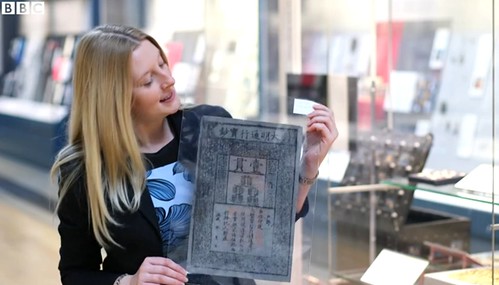
PREV ARTICLE
NEXT ARTICLE
FULL ISSUE
PREV FULL ISSUE
A HISTORY OF MONEY IN FIVE OBJECTS
Arthur Shippee forwarded this BBC News and video of a visit to the British Museum Money Gallery. Thanks! -Editor
As with the new £5 and £10 notes from the Bank of England, being introduced this year and next, the £20 note will be made of plastic. This extends a rich history of changing currency in the UK and worldwide. The plastic notes - starting with the new £5 note featuring Sir Winston Churchill due to be issued in September - will eventually replace cotton paper notes, which have been used for more than 100 years. In many ways, this is a significant change in the way money is produced, not least because a Bank of England banknote will survive a spin in the washing machine for the first time. However, there are many other revolutionary developments in the way money has been made over many centuries. Ben Alsop, curator of the Citi Money Gallery at the British Museum, and Mieka Harris, education manager for the gallery, offer a snapshot of this rich history - with the help of five objects from the gallery's collection. 
This coin made from electrum - a natural alloy of gold and silver found in riverbeds - is one of the earliest examples of coins, and the beginnings of the Western tradition of coinage that is still going strong. It was minted in Lydia, in modern day western Turkey, in the 7th Century BC, making it more than 2,500 years old. These coins, featuring a lion's head, were of a consistent weight and purity. As a result, they held a value that allowed them to be used in cross-border trade - replacing the idea of two commodities effectively being swapped between traders. The tiny coin was of significant value, so was used in high-level trade, as gifts between rulers, and as payment to mercenary soldiers. The vast majority of the population would never see one, and continued to trade without coins - as had been the case for cities and empires for more than 2,000 years. Bartering, for example, still ran in parallel with trading using coins. 
To read the complete article, see:
Here's the video. -Editor

In September the Bank of England will introduce the first £5 notes made of plastic. BBC News visited the Citi Money Gallery at the British Museum to look at five key objects that have been used as monetary tokens in previous societies. To view the video, see:
Wayne Homren, Editor The Numismatic Bibliomania Society is a non-profit organization promoting numismatic literature. See our web site at coinbooks.org. To submit items for publication in The E-Sylum, write to the Editor at this address: whomren@gmail.com To subscribe go to: https://my.binhost.com/lists/listinfo/esylum All Rights Reserved. NBS Home Page Contact the NBS webmaster 
|